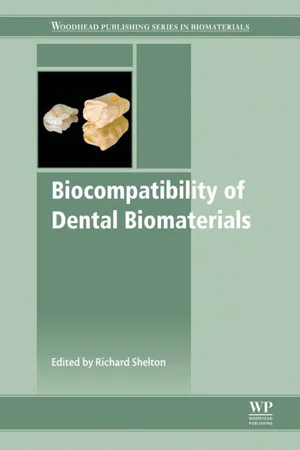
This is a test
- 150 pages
- English
- ePUB (mobile friendly)
- Available on iOS & Android
eBook - ePub
Biocompatibility of Dental Biomaterials
Book details
Book preview
Table of contents
Citations
About This Book
Biocompatibility of Dental Biomaterials details and examines the fundamentals of biocompatibililty, also including strategies to combat it. As biomaterials used in the mouth are subject to different problems than those associated with the general in vivo environment, this book examines these challenges, presenting the latest research and forward-thinking strategies.
- Explores the fundamentals of dental biomaterials and their compatibility
- Presents a thorough review of material specific issues
Frequently asked questions
At the moment all of our mobile-responsive ePub books are available to download via the app. Most of our PDFs are also available to download and we're working on making the final remaining ones downloadable now. Learn more here.
Both plans give you full access to the library and all of Perlego’s features. The only differences are the price and subscription period: With the annual plan you’ll save around 30% compared to 12 months on the monthly plan.
We are an online textbook subscription service, where you can get access to an entire online library for less than the price of a single book per month. With over 1 million books across 1000+ topics, we’ve got you covered! Learn more here.
Look out for the read-aloud symbol on your next book to see if you can listen to it. The read-aloud tool reads text aloud for you, highlighting the text as it is being read. You can pause it, speed it up and slow it down. Learn more here.
Yes, you can access Biocompatibility of Dental Biomaterials by Richard Shelton in PDF and/or ePUB format, as well as other popular books in Tecnología e ingeniería & Ciencias de los materiales. We have over one million books available in our catalogue for you to explore.
Information
Subtopic
Ciencias de los materiales1
Biocompatibility of dental biomaterials
V. Perrotti1, A. Piattelli1, A. Quaranta2, G. Gómez-Moreno3 and G. Iezzi1, 1University “G. d’Annunzio”, Chieti, Italy, 2Oral Health Centre of Western Australia, Nedlands, WA, Australia, 3University of Granada, Granada, Spain
Keywords
Biocompatibility; biological response; interface; human-retrieved implants; biomaterials
1.1 Introduction
Biocompatibility is the ability of a material to elicit an appropriate biological response to a given application in the body. Biocompatibility is not a property of just the material, but rather a property of how the material reacts with its environment. Indeed, Williams in 2008 defined biocompatibility as: “the ability of a biomaterial to perform its desired function with respect to a medical therapy, without eliciting any undesirable local or systemic effects in the recipient or beneficiary of that therapy, but generating the most appropriate beneficial cellular or tissue response to that specific situation, and optimizing the clinically relevant performance of that therapy.”
The most recent thinking regarding biocompatibility is that it is possible to customize interactions at the material–tissue interface. Therefore, several factors must be considered when trying to measure the biological response. The most important factors include:


Table of contents
- Cover image
- Title page
- Table of Contents
- Copyright
- List of Figures
- List of Tables
- List of Contributors
- 1. Biocompatibility of dental biomaterials
- 2. Mechanical biocompatibility of dental materials
- 3. Biocompatibility of fiber-reinforced composites for dental applications
- 4. Biocompatibility of biomaterials for dental tissue repair
- 5. Biocompatibility and functionality of dental restorative materials
- 6. Biocompatibility of luting cements for dental applications
- 7. Biocompatibility of dental amalgams
- 8. Biocompatibility of oral care products
- Index